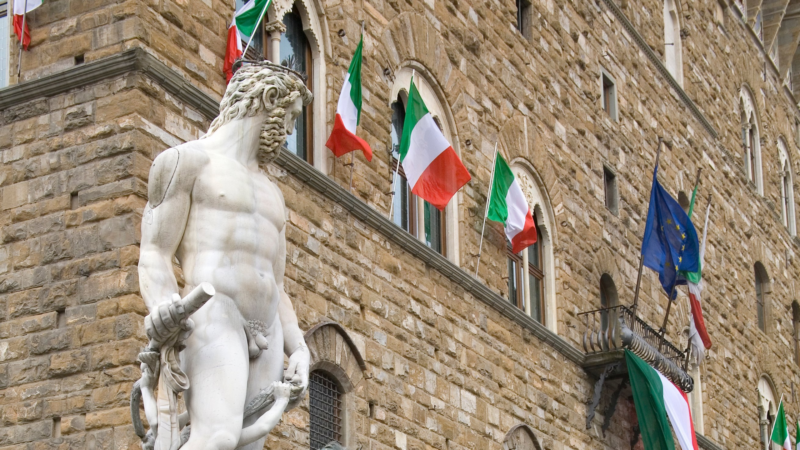Lucky Italians enjoy 12 public holidays a year and many other celebrations. As well as Christmas and Easter, there are also many other unique religious and non-religious holidays celebrated all over Italy! Here are just a few of our favorites:
Carnevale (date differs each year)

Carnevale is the day before Lent begins and the traditional 40 days of abstinence before Easter. In the period leading up to Carnevale, Italians spoil themselves with sweet treats. If you’ve got a sweet tooth, make sure to try frappe, castagnole and zeppole. The traditional recipes call for frying, but nowadays you can often find baked (‘al forno’) versions to save some calories!
At weekends you’ll see kids out in costumes everywhere you go, though adults usually don’t dress up. The exceptions are the famous carnivals of Venice and Viareggio, where the famous annual parade is broadcast live on TV. Carnival in Venice is something else entirely. Wandering the streets in lavish gowns and elegant masks becomes the norm and will get you free access to join the celebrations in St. Mark’s Square if you make the effort.
La Festa delle Donne (March 8)
La Festa delle Donne, or International Women’s Day, is a heart-warming holiday to witness and take part in. You’ll see men of all ages passing out yellow mimosa flowers to women everywhere! Additionally, the day comes with other pleasant perks for women such as free entrance into some national museums and attractions.
La Festa della Liberazione (April 25)
La Festa della Liberazione (Liberation Day) celebrates the victory of the partisans over Fascism at the end of WWII. On April 25th, 1945, a nationwide radio broadcast called on all Italians to opposed the Nazi occupation and Fascist regime in Italy. The uprising started in Bologna the same day and in the coming weeks spread across Italy. By the 2nd of May, Mussolini was dead and the German forces had surrendered.
Each year, the President of the Italian Republic visits the Tomb of the Unknown Soldier in Rome to remember all those who died. But as it’s close to Labor Day on May 1st, many Italians plan a spring vacation, without using up too many vacation days!
La Festa della Repubblica (June 2)

La Festa della Repubblica is the Italian national celebration. This holiday marks the day in 1946 when Italians collectively voted to end the monarchy and transition to a Republic.
At the end of WWII, the monarchy was unpopular for their support of Mussolini. 54.3% of Italians voted for a Republic and there were clashes in many cities. For 6 days the king refused to accept the result, but as civil unrest grew, the royal family eventually went into exile.
Today, there is usually a huge, patriotic military parade in the center of Rome. While this hasn’t been possible during the pandemic, the Frecce Tricolori (the acrobatic team from the Italian Airforce), have taken centerstage performing incredible displays watched from balconies and terraces around Italy.
Ferragosto (August 15)

August 15th is an important Catholic holiday that celebrates the Virgin Mary’s ascension to heaven. Today, Ferragosto is also the start of Italy’s major summer holiday. The public holiday only lasts one day, however, you will find that many businesses close from August 15th until the beginning of September, which can be frustrating for visitors. If you’re planning on visiting in August, museums and sites stay open, but you may find many restaurants and family-owned businesses closed.
Ognissanti (November 1)
Halloween is slowly gaining popularity in Italy, but the major holiday here is the following day.
Pope Gregory II started the celebration of All Saints’ Day in the 7th century for churchgoers to celebrate all of the Catholic saints. Many Italians travel home to celebrate Ognissanti and visit cemeteries to remember their departed relatives on November 2nd (All Soul’s Day).
L’Immocolata (December 8)

L’Immocolata, or the Immaculate Conception of Mary, is another Italian public holiday with religious origins. As well as a festival to the Virgin Mary, it is also considered the start of the Christmas season. On this day, Italians put up their Christmas trees and festive lights are turned on.
In Rome, the Pope celebrates the day with a visit to the statue of the Virgin Mary in Piazza di Spagna. While he leads prayers, the city’s fire brigade put a wreath at the foot of the statue, 11.8m up in the air!
Regional Holidays
Each Italian city celebrates the feast day of its patron saint with a public holiday. Don’t be surprised to find shops closing early (or not opening at all) on these days, though restaurants and museums usually stay open.
Venice
The Feast of St Mark on April 25th is also known as the Rosebud Festival where it’s traditional to give a single rosebud to the one you love.
Florence
The locals know how to have fun on June 24th to celebrate the Feast of St John the Baptist. They organize parades, a historic soccer match and a spectacular firework display in the evening.
Rome
The Feast of St Peter and St Paul centers on the basilicas where the saints are buried: St. Peter’s and St. Paul’s outside the Walls. It is observed every year on June 29th. Among other festivities, there is a magnificent firework display in Piazza del Popolo, a tradition since 1481 when Michelangelo first came up with the idea.
Naples
If you are in Naples on September 19th for the Feast of St Gennaro, make sure to visit the Duomo. Inside there is a phial of the saint’s dried blood which sometimes liquifies on his feast day, a good omen for the year ahead.
Milan
December 7th is the Feast of St Ambrose in Milan. It’s also the day before L’Immocolata on December 8th, so citizens of Milan enjoy at least 2 days off. The famous La Scala opera house opens its season tonight. This is an important event for opera lovers, so make sure to book tickets well in advance.
